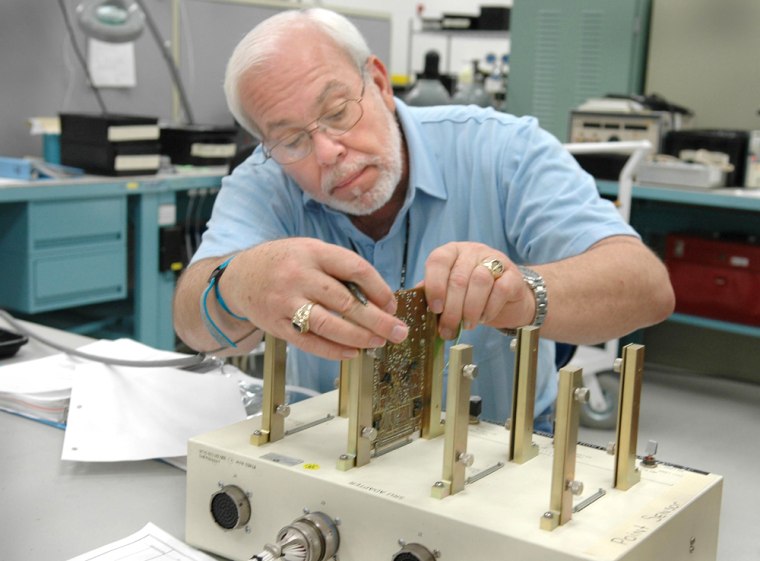Engineers will continue troubleshooting the puzzling fuel-tank sensor glitch that forced a postponement of NASA's first shuttle launch in more than two years, mission managers said Monday.
July 26 would be the earliest date that NASA could try launching the shuttle Discovery again, they said.
Hundreds of engineers worked to troubleshoot the problem over the weekend, to no avail, said shuttle program manager Bill Parsons. So far, no fault has been found in the sensor system's electronics.
"Right now we're still looking for the problem," Parsons said during a news briefing at NASA's Kennedy Space Center in Florida.
Deputy shuttle program manager Wayne Hale said that engineers would take two more days to check the circuitry and electronics connected to the tank sensors. If they haven't found the problem by that time, NASA would reload the tank with superchilled liquid hydrogen and oxygen — then look for signs of failure.
"Our No. 1 goal here is to find this problem and fix this problem," Hale said.
Hale said July 26 was the earliest date that Discovery could be fueled up and launched, even under the most optimistic circumstances. If a tanking test was done on that day instead, and if the tank passed the test, Hale said the preferred course would be to launch on the next day, July 27.
Discovery's seven-astronaut crew was due to fly back to Texas on Tuesday for a brief stint of training at NASA's Johnson Space Center, then return to Florida in plenty of time for the next launch attempt, the space agency said.
Running on empty?
Last Wednesday's countdown was called off less than two and a half hours before launch due to the glitch, which involves a low-level sensor in the liquid-hydrogen compartment of the fuel tank — devices analogous to the "E" indicator in a car's gas tank.
The card-sized sensors, also known as engine-cutoff sensors or ECO sensors, come into play only if the shuttle's hydrogen-oxygen propellants are close to running out. In that case, the engines shift into a safe shutdown mode. If the sensors don't work properly, the shuttle's computers might shut down the engines too soon — or keep them running on empty, which poses a risk of serious damage to the propulsion system.
There are four such sensors in the fuel tank's liquid-hydrogen compartment — an arrangement that provides a measure of redundancy in case of failure during launch. Under NASA's rules, all four have to be operative for the countdown to proceed, although only two need to be working correctly during the ascent to orbit.
Discovery's sensors have been acting up for months: The system flunked one tanking test in April, then passed another one in May. Then Discovery's tank was swapped in June for a newer heater-equipped tank, and the launch team had thought the problem was solved. During last week's countdown, however, one sensor started exhibiting bad readings on an intermittent basis.
Now that the tank is empty, the sensor seems to be working as expected — complicating NASA's troubleshooting efforts.
"It's difficult to find a glitch that won't stay glitched," Parsons said.
If the troubleshooters are unable to find the source of the problem, NASA managers could reconsider their rules to allow for a launch even if one of the four low-level sensors isn't working, Hale acknowledged. "We're thinking about it," he said. But for the time being, the mission management team was putting aside that scenario, pending the outcome of the upcoming tests.
First since Columbia
Discovery's resupply mission to the international space station would mark the first space shuttle flight since the catastrophic breakup of the shuttle Columbia in February 2003. That tragedy killed Columbia's seven crew members and forced the grounding of the rest of the shuttle fleet.
Investigators determined that a piece of flying foam insulation from Columbia's external fuel tank cracked a hole in the orbiter's left wing shortly after launch, setting the stage for hot gases to enter the hole and destroy the shuttle during atmospheric re-entry 16 days later. In response, NASA has made dozens of safety upgrades in the shuttle orbiter and fuel tank, and has created new procedures to inspect the shuttle for damage.
NASA wants to have daytime conditions for launching the shuttle and monitoring the fuel tank during the ascent for signs of damage. That consideration — plus the need to rendezvous on time with the space station — means that the current launch window extends only until July 31. Parsons said the window could be extended a few days into August, although in that case, the imagery of the fuel tank would not be as good.
If the current window closes without launch, the next window opens up on Sept. 9.
